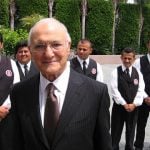Tupac’s Coachella Cameo: Groundbreaking for Traffic Signs, Too
Tuesday, April 17, 2012 —
This past weekend at Coachella, thousands of fans watched in awe as Dr. Dre and Snoop Dogg took the stage with the late Tupac Shakur. The legendary rapper, who was killed in a drive-by shooting in 1996, was projected via hologram to perform a set with the two contemporary hip-hop celebrities. The holographic projection, designed by immersive technology company AV Concepts, used a combination of found footage and computer-generated animation to produce a likeness of the rap martyr. Shakur performed “Hail Mary” and “2 of Amerika’z Most Wanted.” Attendees reported that the most jarring moment of the performance was when the hologram greeted the audience with a casual, “What’s up Coachella?” The real Tupac died two years before the first Coachella music festival was even organized.
The holographic projection of late rapper Tupac at Coachella 2012.
AV Concepts has designed similar works of integrative technology for Chris Brown’s multi-level stage during the 54th Annual Grammy’s, and Kelly Osbourne’s pink transformation of a Hard Rock Hotel for Susan G. Komen for the Cure. But this technology has the power to be more than just a surreal crowd-pleaser. This three-dimensional imaging system has been identified as a potential game-changer in the traffic sign industry.
In Russia, physicists have suggested the use of holographic speed limit signs to attract drivers’ attention. Flashy billboards and advertisements often oversaturate roads with information and images. Such roadside distractions often impede drivers’ adherence to traffic regulations. Physicists in support of this technologically advanced signage system argue that holograms are more likely to draw the attention of drivers whose visual sensibilities are already hyper-stimulated, due to their three-dimensional capabilities and bright displays. Iridescent holograms, with the capacity to be viewed from anywhere between 1° and 180°, have the ability to contain several messages that are visible from different angles. The bold signs can also be programmed to shine brighter or blink when vehicles are approaching.
A futuristic interpretation of holographic street signs
Another perk of electronic traffic signs in general is their ability to respond to specific events in a tailored, specially programmed fashion. For example, a regular stop sign can never know where pedestrians or vehicles are on the road at any given time. However, a programmable sign could warn drivers of children crossing the road up ahead and children of drivers approaching at a high speed. The holographic element of such a reactive piece of signage just adds to its visibility to foot and car traffic.
Do you think it’s wise to give signs that much personalized power? And is it logical to try and outperform flashy roadside distractions instead of getting rid of them? Let us know in the comments section below!
– R. Sapon-White
Related Posts
Category: News



















